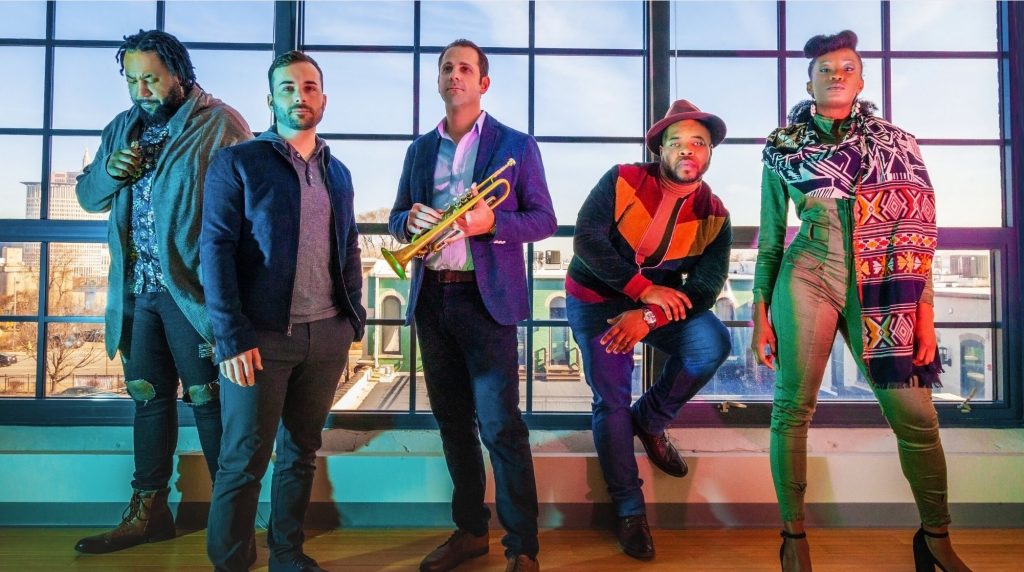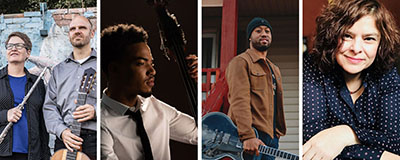By Daniel Hathaway
We’ll list this weekend’s events by category:
ORCHESTRA CONCERTS will feature Barbara Hannigan conducting The Cleveland Orchestra with soprano Aphrodite Patoulidou (read an interview here) on Saturday evening, and Kelly Corcoran conducting the Canton Symphony with Julie Sarver, piccolo in a “Baroque Bash” on Saturday,
Also on Saturday, Matthew Salvaggio will conduct the Cleveland Repertory Orchestra in music by Margaret Brouwer, including the premiere of her Saxophone Concerto featuring Andrew Hosler. And on Sunday afternoon, the Cleveland Orchestra Youth Orchestra will play its fall concert under the baton of Daniel Reith in a program that includes Walter Piston’s The Incredible Flutist: Suite, and Beethoven’s Symphony No. 5 (read a preview here).
GUITAR PERFORMANCES: On Saturday, the Cleveland Classical Guitar Society’s Showcase Concert (artists pictured) will present the Gruca White Ensemble (guitarist Robert Gruca and flutist Linda White), Brazilian singer Luca Mundaca, jazz guitarist-composer Dan Wilson & bassist Brandon Rose at the Maltz (read an interview with Dan Wilson here), and on Sunday, Andrew Flory will play a Theorbo and Guitar Program at the Church of the Western Reserve on Sunday.
CHAMBER MUSIC: On Sunday the CIM New Music Ensemble celebrates the music of Kaija Saariaho in Mixon Hall (read a preview here).
A SOLO CONCERT on Sunday will feature opera composer Jake Heggie, who will give a recital of his arias and songs in Warner Concert Hall during his visit to Oberlin.
For details of these and other events, visit our Concert Listings.
WEEKEND ALMANAC:
November 11 — by Mike Telin:

Armistice Day was first held at Buckingham Palace one year later. Since then many countries have renamed November 11 Remembrance Day, while the United States chose the name Veterans Day in 1954, following World War II and the Korean War. Today, this federal holiday honors those who have served in the U.S. Armed Forces in war or peace, whether they’re living or deceased, provided they have not been dishonorably discharged.
Perhaps no place honors those who answered that call to serve more appropriately than Arlington National Cemetery. And no location within the Cemetery honors those who lost their lives more poignantly than the Tomb of the Unknown Soldier.
November 11, 2022 marked the centennial of the first soldier to be laid to rest in the Tomb of the Unknown, and in honor of the occasion, D.C.-based opera company UrbanArias commissioned a song cycle from composer Shawn Okpebholo and poet Marcus Amaker. The film version of their new cycle, UNKNOWN, is now available online.

The artistic team includes trumpeter Dominick Farinacci, broadcast journalist and Vietnam War Veteran Leon Douglas Bibb, theatrical creator and storyteller Emmett Murphy, vibraphonist, pianist, composer and arranger Christian Tamburr, lighting designer Garrett Caine, vocalist Shenel Johns, pianist and pastor Dr. Lafayette Carthon Jr., poet and spoken-word artist Orlando Watson, vocalist and composer Will Blaze, percussionists Jamey Haddad and Salar Nadar, drummer Gabe Jones, and bassist Walter Barnes Jr.
The producers write on their website, “We are pleased to announce our recently completed film adaptation of Modern Warrior LIVE featuring our full performance, available for in-person and streaming showings. This option can also give organizations that are operating remotely or in smaller settings the opportunity to experience the full impact of our show.”
November 12 — by Jarrett Hoffman
This date in history brought the “finales,” we could say, of American composer and academic Walter Piston (who died on November 12, 1976), Polish composer Henryk Górecki (who followed suit in 2010), and English composer John Tavener (who in 2013 met his maker — one can assume to a friendly reception, given the composer’s preference for religious choral music).
One of Piston’s greatest pieces is the suite he drew from his ballet The Incredible Flutist — and the Cleveland Orchestra Youth Orchestra will play it on their fall concert this Sunday. (Read a preview here.)
For Górecki, have a listen to his Third Symphony (“Symphony of Sorrowful Songs”). Dedicated to victims of the Holocaust, it was written in 1976 but took fifteen years to make its way into the ears of most listeners outside of Poland, when it also basically introduced the composer to the rest of the world. And it did so with a bang — the London Sinfonietta’s 1992 recording topped the American and British classical music charts, and has continued to rack up sales far beyond what would be expected from similar albums.
Listen to that very recording here, where the orchestra is led by David Zinman, and the soloist is soprano Dawn Upshaw.
As Górecki said in an interview, “Perhaps people find something they need in this piece of music…Somehow I hit the right note, something they were missing…I feel that I instinctively knew what they needed.”
And returning to locally connected recordings — at Trinity Cathedral in 2013, Ross Duffin and Quire Cleveland performed Tavener’s The Lamb, one of the most commercially successful among his renowned religious works.
As Quire points out in the description of the video, “Tavener plays on the innocence of the lamb by featuring only high voices at the beginning…” And though basically the same musical ideas continue, “the doubling of low voices for the second stanza gives a much different musical impression…”
You’ll also enjoy the dissonances, which are decidedly tasty — perhaps something else, aside from the symbolism of a young child and of Jesus, that Tavener had in mind regarding the lamb?




